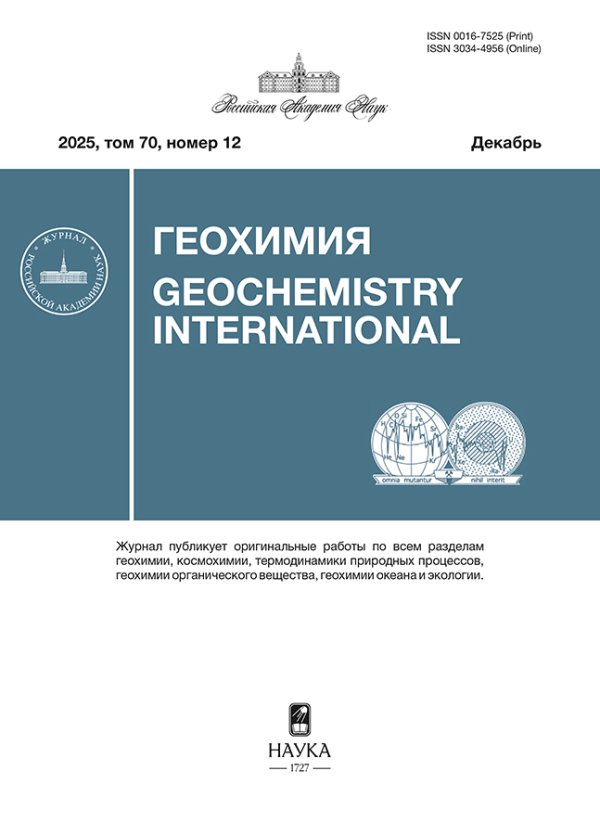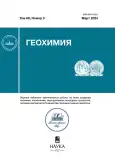Том 69, № 3 (2024)
Статьи
Распределение редких элементов между минералами и расплавом: параметризация экспериментальных данных для оливина, пироксенов и полевых шпатов
Аннотация
Проведен анализ экспериментальных данных по распределению микроэлементов между минералами (оливином, ортопироксеном, клинопироксеном и полевыми шпатами) и силикатными расплавами. Использованные данные охватывают широкий интервал условий (от 1 атм до 10 ГПа и ~1000–2000 °C), а также составов расплавов (от ультраосновных до ультракислых) и минералов. Зависимости логарифмов коэффициентов распределения (lnDi) от условий и составов аппроксимированы линейными функциями от 1/T, P/T (P – давление и T – абсолютная температура) и параметров состава минералов и расплава. Установлено также, что отношения Di /Dj для большого количества пар элементов не зависят от экспериментальных параметров и варьируют в узких пределах. Параметры зависимостей Di от условий и составов оценены минимизацией квадратичных отклонений модельных значений Di и Di /Dj от экспериментальных. Полученные зависимости позволяют рассчитывать Di для большого количества элементов с точностью примерно до множителя 1.2–2.0. Используя полученные оценки, в качестве примера рассматривается модель образования мафических расплавов базальтов срединно-океанических хребтов при плавлении перидотитового источника и кристаллизации первичных магм в коровых условиях.
 227-240
227-240


Оценка возраста и условий метаморфизма высокобарных бластолитов Гонжинского блока Аргунского супертеррейна восточной части Центрально-Азиатского складчатого пояса
Аннотация
В результате петрографических и термобарических исследований в линзе бластолитов в рассланцованных породах Гонжинского блока были выделены 4 минеральных ассоциации: реликтовая, главная, ассоциация, отвечающая биотитизации, и ассоциация ретроградных изменений. Реликтовая ассоциация, вероятно, представляла собой эклогиты. Главная минеральная ассоциация отвечает апоэклогитовым цоизитовым амфиболитам. Определение Р–Т–параметров формирования этой ассоциации показало интервал Р = 13.0–15.0 кбар и Т = 580–670 °С. В то же время, если для расчетов принять наиболее железистую внешнюю кайму амфибола-1, то Р–Т-параметры смещаются в более высокотемпературную область Р = 13.0–17.0 кбар и Т = 660–780 °С. Ассоциация, отвечающая наложенной биотитизации, хорошо структурно выражена. Линии мономинеральных равновесий биотитовой ассоциации, построенные по различным комбинациям составов граната, биотита и плагиоклаза, показали хорошее схождение в локальной области, отвечающей интервалу Р = 12.5–13.2 кбар и Т = 810–830 °С. В последнюю ассоциацию ретроградных изменений входит низкоглиноземистый амфибол-2. По полученным изотопным Sm–Nd данным построена изохрона для валового состава породы, граната и двух амфиболов. Возраст по изохроне составляет 171 ± 3 млн лет. Последний интерпретируется как время формирования главной минеральной ассоциации и соответствует ее кристаллизации на пике метаморфизма.
 241-251
241-251


Геохимия и условия формирования мезоархейских полосчатых железистых кварцитов (BIF-1) Костомукшского зеленокаменного пояса Карельского кратона
Аннотация
В Костомукшском зеленокаменном поясе (КЗП) Карельского кратона известно три разновозрастных группы полосчатых железистых кварцитов (banded iron formation – BIF). Наиболее ранние из них – мезоархейские (2.87–2.81 млрд лет) – BIF-1 рассматриваются в данной статье. BIF-1 залегают среди базальт-коматиитовой толщи КЗП. Они состоят преимущественно из кварца и магнетита с варьирующим количеством амфибола, биотита, граната. Содержание в них SiO2 – 48.3–58.6 мас. %, а Fe2O3T – 21.34–33.82 мас. %, что позволяет рассматривать породы как BIF. Также как и большинство архейских BIF они характеризуются высоким содержанием Fe2O3T, наличием контрастной положительной Eu-аномалии, отсутствием Ce-аномалии, обеднением ЛРЗЭ относительно ТРЗЭ. Вместе с тем, они выделяются среди других BIF высоким содержанием Al2O3, TiO2, MgO, K2O, Cr, Ni, Zr, Ba, Cu, Zn. Формирование BIF-1 происходило в морском бассейне при бескислородной атмосфере как за счет гидротермальных флюидов, доля которых варьируется от 20 до 80 %, так и терригенной составляющей, главным источником которой являются базальты, коматииты, дациты вмещающих пород. Мезоархейские BIF-1 КЗП образовались в небольших рифтогенных структурах в пределах океанического вулканического плато, становление которого связано с воздействием мантийного плюма на океаническую литосферу.
 252-274
252-274


Экспериментальное исследование устойчивости MoO2Cl2°(р-р) в гидротермальных растворах при 100–350 °С и давлении насыщенного пара
Аннотация
Исследована растворимость кристаллического MoO3 в растворах HCl с переменной концентрацией при 100, 155, 200, 250, 300, 350 °C и давлении насыщенного пара. Результаты показали, что растворимость MoO3 увеличивается с ростом концентрации HCl. С использованием программы OptimA по экспериментальным данным определены свободные энергии комплекса MoO2Cl2, по которым рассчитаны константы устойчивости MoO2Cl2 согласно реакции: MoO3(к) + 2HCl(р-р) → MoO2Clо2(р-р) + H2O(ж). Значения pK составили: 1.07 ± 0.29; 1.06 ± 0.49; 1.74 ± 0.71; 1.83 ± 0.47; 1.50 ± 0.28; 0.95 ± 0.57 при 100, 155, 200, 250, 300, 350 °C (давление насыщенного пара).
 275-282
275-282


Дестинезит: физико-химическое и калориметрическое изучение
Аннотация
Исследован дестинезит состава (Fe3+ Al0.02)(PO4)0.99(SO4)0.90(OH)1.20⋅5.97H2O (Чехия) методами термического и электронно-зондового анализов, порошковой рентгенографии, ИК, КР и мессбауэровской спектроскопии. Методом калориметрии растворения в расплаве бората свинца 2PbO∙B2O3 на микрокалориметре Кальве “Setaram” (Франция) определена энтальпия образования дестинезита Fe2 (PO4)(SO4)(OH)⋅6H2O из элементов ∆fH 0(298.15 K) = −4258 ± 12 кДж/моль. Оценено значение его абсолютной энтропии S0(298.15 K) = 462.0 Дж/(моль·K), рассчитаны энтропия образования ∆fS0(298.15 K) = −2054.4 Дж/(моль·K) и энергия Гиббса образования из элементов ∆fG0(298.15 K) = −3646 кДж/моль.
 283-292
283-292


Лито-, минерало- и геохимическая специфика формирования нижнемэотических отложений природного заповедника “Казантипский”, Крым
Аннотация
В статье представлены результаты изучения карбонатных и сульфатно-карбонатно-глинистых пород нижнего мэотиса в разрезах бухт мыса Казантип комплексом аналитических методов. Установлено, что наибольшим варьированием химического, битуминологического, фазового и изотопного состава углерода характеризуются карбонатно-глинистые и глинистые породы основания разреза. Доказано, что исходное ОВ накапливалось, в основном, в восстановительных условиях, но имеет некоторые вариации в своем составе; характеризуется низкой степенью его катагенетического преобразования, что говорит о сохранении первичного изотопного состава. Выявлен разнообразный фазовый состав глинистой фракции – диоктаэдрический иллит, каолинит, хлорит, глауконит и слабоупорядоченные смешанослойные образования типа иллит/смектит с различным соотношением иллитовой и смектитовой компоненты и варьирующей степенью упорядоченности. Моделирование их дифракционных профилей показало, что иллит/смектитовая структура может свидетельствовать о значительных глубинах мобилизации осадков грязевыми вулканами. Установлено, что изотопный состав 13Сorg колеблется в широких пределах от –33.72 до –19.27 ‰ при моде –22.1…–24.93 ‰. Изотопное облегчение 13Сorg ниже –25.6 ‰ может быть связано с вхождением в ОВ изотопно-легкой массы метанокисляющих бактерий. Выявлено, что вариации кривых изотопного состава 13Сcarb и 13Сorg исследованных пород по разрезу редко характеризуются однонаправленными (положительными и отрицательными) вариациями и имеют разные тенденции по разрезу. Направленность кривой изотопного состава 13Сcarb с некоторыми вариациями имеет выраженную тенденцию к утяжелению вверх, тогда как изотопные значения 13Сорг – на облегчение. Полученные результаты доказывают, что выявленные вариации состава ОВ и изотопии углерода в разрезах нижнего мэотиса мыса Казантип отражают колебания в условиях седиментации температуры, солености, ингрессии пресных вод, колебания биопродуктивности и влияние локальных газофлюидных высачиваний. Предлагается использовать такие акцессорные минералы как циркон, монацит, ильменит в качестве индикатора грязевого палеовулканизма.
 293-309
293-309


Хроника Всероссийского ежегодного семинара по экспериментальной минералогии, петрологии и геохимии 2023 года
Аннотация
11–12 апреля 2023 года в Москве прошел юбилейный Всероссийский ежегодный семинар по экспериментальной минералогии, петрологии и геохимии, организованный Институтом геохимии и аналитической химии им. В.И. Вернадского и Институтом экспериментальной минералогии им. Д.С. Коржинского РАН. На семинаре были рассмотрены новые результаты экспериментальных исследований по основным направлениям: фазовые равновесия при высоких Р–Т параметрах; образование и дифференциация магм; взаимодействие в системах флюид-расплав-кристалл; гидротермальные равновесия и рудообразование; синтез минералов; термодинамические свойства минералов, расплавов и флюидов; планетология, метеоритика и космохимия; физико-химические свойства геоматериалов; экспериментальная геоэкология; методика и техника эксперимента. В работе семинара приняло участие около 250 ученых из 37 Российских научных Институтов и 7 зарубежных организаций, представлено более 160 докладов.
 310-320
310-320












